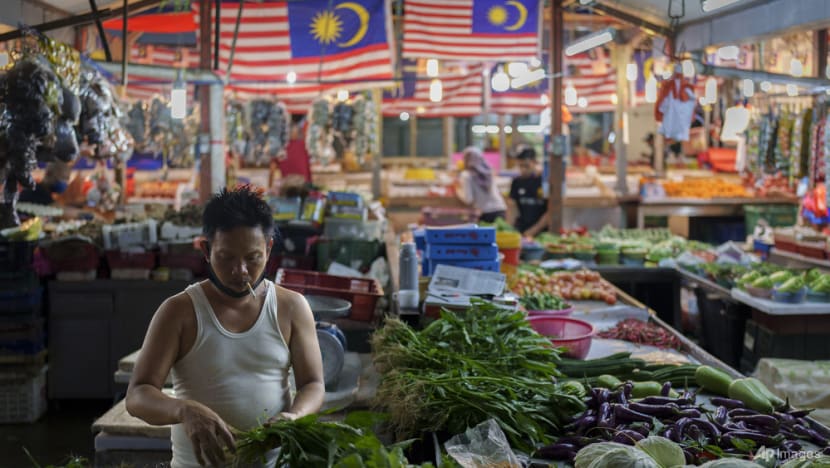CNA Explains: Why is Malaysia considering the reintroduction of GST and how receptive are businesses?

A fresh vegetable vendor prepares for business at a wet market in downtown Kuala Lumpur, Malaysia, Thursday, Dec. 9, 2021. (AP Photo/Vincent Thian)
KUALA LUMPUR: Last week, Malaysian Prime Minister Ismail Sabri Yaakob reportedly said that the government was keen on reintroducing the Goods and Services Tax (GST).
In an interview with Nikkei, he noted that the GST was unpopular but said that the government had limited options because it had lost around RM20 billion (US$4.57 billion) in revenue after the tax was abolished.
The GST, levied at a blanket 6 per cent, was introduced in April 2015 by former prime minister Najib Razak to replace the Sales and Services Tax (SST).
GST was a hot button issue in the run-up to Malaysia’s 14th General Election. Pakatan Harapan (PH) promised to abolish the tax if it took power. During its stint as the ruling government, PH abolished the GST in June 2018 and reinstated the SST. The latter has remained in place even after the PH government fell in March 2020.
As Malaysia recovers from the pandemic and seeks ways to increase federal revenue, there have been suggestions that the GST, as a broad-based consumption tax, may be a potentially useful fiscal tool.
Mr Ismail Sabri’s recent remarks on GST has sparked a debate in Malaysia.
Generally, business federations have been supportive of the idea. However, PH issued a statement on Jun 1, saying that reintroducing GST amid rising inflation would place a burden on the people.
“Reintroducing GST has the potential to increase the price of goods drastically. If added with supply chain problems and stagnant wages, the people will face terrible pressure,” it said.
PH also claimed that public perception of the current administration’s governance has yet to recover from the 1Malaysia Development Berhad (1MDB) scandal.
The opposition coalition said it was unreasonable for the government to increase tax collection from the people without proving that it had reformed and improved its administration.
Over the weekend, the prime minister stated that Putrajaya was still studying whether to reintroduce the GST and has yet to make a decision.
"Many people started jumping when I said the government was ‘not ruling out the possibility’ (of reintroducing GST), but I also said we needed to study the negative and positive aspects of it first,” he was quoted as saying by Malaysian media.
WHY GST IS BEING CONSIDERED AGAIN
In 2020, Malaysia’s economy contracted by 5.6 per cent due to the pandemic. But there were signs of recovery in 2021 as the economy grew by 3.1 per cent.
The economic growth for this year is forecasted to be between 5.5 per cent to 6.5 per cent. Recent developments, including the Russia-Ukraine war and supply chain disruptions, may have a negative impact on economic recovery from COVID-19.
Last November, Finance Minister Tengku Zafrul Aziz tabled a RM332.1 billion budget for 2022, the country’s largest ever on record.
At that time, Mr Tengku Zafrul noted that the government expected revenue to drop by 1.22 per cent. He forecasted a 6 per cent deficit this year, or RM98.1 billion.
While most businesses are starting to recover from the economic disruption caused by lockdowns over the past two years, ordinary Malaysians are feeling the pinch of rising prices of key commodities such as chicken and fish.
Concurrently, there is the issue of the rising cost of living and diminished purchasing power, as the ringgit’s value slipped against the US dollar and other major currencies
Under the existing SST system, the Malaysian government collected an estimated revenue of RM 26.7 billion and RM27.9 billion in 2020 and 2021 respectively.
As compared to 2017 before the GST was abolished, the figure stood at RM44 billion.
Petroleum sales have accounted for a major portion of the federal revenue. But the country’s oil reserves have been dwindling, and Malaysia has in fact become a net oil importer since 2014.
Given the fiscal deficit and the need to boost federal revenue collection, there have been calls, particularly from United Malays National Organisation (UMNO) senior leaders including Najib, to consider reinstating the GST.

WHAT ARE THE KEY DIFFERENCES BETWEEN GST AND SST?
Under the current SST regime, there is a tax of between 5 per cent and 10 per cent on the sale of goods, while services attract a 6 per cent levy.
In comparison, the former GST regime covered a broader range of items and services with the rate set at 6 per cent.
Sunway University's Professor of Economics Yeah Kim Leng explained that under the GST regime, 60 per cent of the goods and services in the Consumer Price Index (CPI) basket were taxed. For SST, there is a narrower tax base where only 38 per cent of goods and services in the CPI basket are subject to taxes.
The academic explained that GST was a more efficient taxation system compared to SST, as the latter was imposed on production inputs, and thus added to manufacturers' costs.
The GST, on the other hand, is a tax on the added value of a final product or service. Manufacturers would be refunded the GST they had paid, and this would lower production costs.
“It results in a more efficient economic system with less distortions caused by taxes,” Prof Yeah explained.
“Also, as GST is a tax on consumption, the more one consumes, the higher the contribution to tax collection,” he said.

Mr Hafidzi Razali, a senior analyst with strategic advisory firm Bower Group Asia, said the GST’s regressive nature, which means there is a higher tax burden on the lower-income earners, made it unpopular on the ground.
While the GST was in place, Mr Hafidzi recounted that businesses had faced delays in their tax reimbursements. This affected their cash flow, particularly for small and medium enterprises.
“At one point, the Barisan Nasional government owed RM19.4 billion in tax refunds to over 120,000 companies, with less than RM1.5 billion left in the repayment fund,” he recounted.
The shortfall was only settled after then finance minister Lim Guan Eng announced an RM30 billion special dividend from Petronas, part of which went towards paying off those outstanding GST refunds.
“The reintroduction of GST will have to take into account this implementation gap, as SMEs cannot afford a similar experience, especially in this post-pandemic period of economic recovery,” the analyst said.

This impact of GST on SMEs was also echoed by Mr Nivas Ragavan, the president of the Kuala Lumpur and Selangor Indian Chamber of Commerce and Industry (KLSICCI).
Mr Nivas told CNA that many small businesses, including his own chamber members, were impacted when GST was implemented in 2015.
The new tax system made it compulsory for all businesses with an annual turnover of RM500,000 and upwards to register for GST purposes.
“GST brings more revenue (for the government), because SST only reaches the import and manufacturing level for goods compared to GST (which goes up to the retail level).”
“However, our members felt that the government should set the threshold value above RM1 million, and not a minimum of RM500,000 so that small businesses are not impacted by the reintroduction,” he said.
The threshold for SST is also set at RM500,000. For businesses in the food and beverage industry, they are subject to a higher threshold of RM1.5 million.

ARE BUSINESSES RECEPTIVE TO THE IDEA?
Generally, the business groups have reacted positively.
Mr Nivas of KLSICCI opined that the previous GST system was an efficient and fair taxation system. He claimed that the decision to abolish GST by the PH government was a political decision based on an election promise rather than sound economic principles.
“In the long term, the price of goods will be stabilised with the implementation of the GST taxation system,” he argued.
Similarly, the president of the Federation of Malaysian Manufacturers (FMM), Mr Soh Thian Lai said in a statement on Jun 2 that he welcomes the proposal for a GST regime that would not burden the people but at the same time, widen the revenue base of the government.
“The GST is a more transparent and effective tax regime compared to the SST … GST provides a fairer tax structure and it eliminates cascading and compounding of taxes commonly found in the SST regime.”
“In addition, prices of Malaysian exports will become more competitive on the global stage as no GST is imposed on exported goods and services, while GST incurred on inputs can be recovered along the supply chain,” the statement added.
“The government should not consider GST in isolation, but as part of a holistic assessment of Malaysia’s tax systems and the country’s fiscal position,” the trade body added, bearing in mind that the focus was now on economic revival and business-rebuilding.
While the trade body also suggested that all essential goods and services be zero-rated, FMM also suggested that the registration threshold stay at RM500,000, and that the government should minimise the delay in refunds.
Related:
If the GST regime makes a comeback, Prof Yeah of Sunway University said that small businesses will need to cope with a likely one-off increase in inflation and business costs.
“They will need to invest time and resources in learning and managing the GST to derive the benefits of the value-added tax system while reducing the compliance costs,” he said.
“To overcome this problem that plagued the previous implementation, the minimum threshold for GST registration could be raised.”
In contrast, he said that the larger companies would already be familiar with the former GST regime, including having customised software to deal with tax compliance. The scenario where GST is reintroduced would therefore be “less problematic” from their perspective, he added.
POTENTIAL IMPLEMENTATION TIMEFRAME
There is also the issue of timing.
Both analysts interviewed by CNA said that even if the government made a decision, the GST would not be implemented so soon.
Mr Hafidzi of Bower Group Asia said that Mr Ismail Sabri would need strong political support to reintroduce GST. Given Barisan Nasional’s (BN) slim parliamentary majority right now, this would not be possible, he said.
"The PM’s decision may also not be necessarily agreed by his Cabinet ministers from Perikatan Nasional, as the unpopular GST factor (among the grassroots) may negatively affect their chances in GE15."
"Realistically, this may only be implemented post-GE15 when UMNO-BN’s political positioning is clearer and presumably better," he noted.
Prof Yeah noted that on the ground, there are still lingering concerns over the regressive impacts of GST on the lower income groups.
"They will be shouldering a higher share of the tax burden relative to their income or expenditure."
"Hence, in addition to zero-rating and exemptions being granted for essential goods and services, the government may need to provide additional off-setting measures to address the negative impact on low income households," Prof Yeah added.
On Wednesday (Jun 8), the finance minister reportedly said that It will take at least nine months before the GST can be reinstated after it is approved by parliament. He added that this process will take time, including conducting a study and engaging the stakeholders.



















